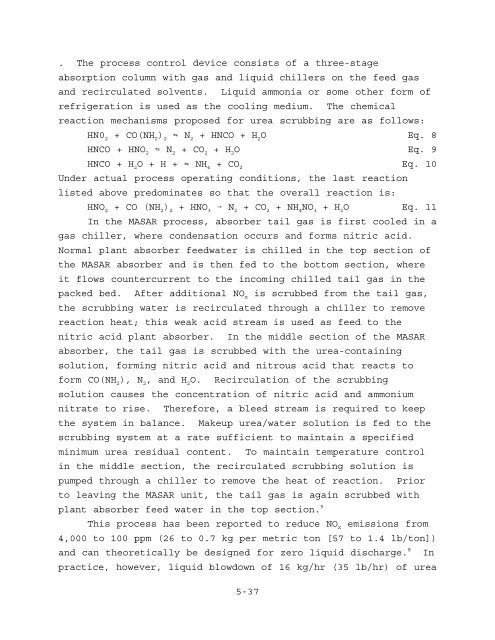Alternative Control Techniques Document— Nitric And Adipic Acid
Alternative Control Techniques Document— Nitric And Adipic Acid
Alternative Control Techniques Document— Nitric And Adipic Acid
Create successful ePaper yourself
Turn your PDF publications into a flip-book with our unique Google optimized e-Paper software.
. The process control device consists of a three-stage<br />
absorption column with gas and liquid chillers on the feed gas<br />
and recirculated solvents. Liquid ammonia or some other form of<br />
refrigeration is used as the cooling medium. The chemical<br />
reaction mechanisms proposed for urea scrubbing are as follows:<br />
HN0 + CO(NH ) X N + HNCO + H O Eq. 8<br />
2 2 2 2 2<br />
HNCO + HNO X N + CO + H O Eq. 9<br />
2 2 2 2<br />
HNCO + H O + H + X NH + CO Eq. 10<br />
2 4 2<br />
Under actual process operating conditions, the last reaction<br />
listed above predominates so that the overall reaction is:<br />
HNO + CO (NH ) + HNO 6 N + CO + NH NO + H O Eq. 11<br />
2 2 2 3 2 2 4 3 2<br />
In the MASAR process, absorber tail gas is first cooled in a<br />
gas chiller, where condensation occurs and forms nitric acid.<br />
Normal plant absorber feedwater is chilled in the top section of<br />
the MASAR absorber and is then fed to the bottom section, where<br />
it flows countercurrent to the incoming chilled tail gas in the<br />
packed bed. After additional NO is scrubbed from the tail gas,<br />
x<br />
the scrubbing water is recirculated through a chiller to remove<br />
reaction heat; this weak acid stream is used as feed to the<br />
nitric acid plant absorber. In the middle section of the MASAR<br />
absorber, the tail gas is scrubbed with the urea-containing<br />
solution, forming nitric acid and nitrous acid that reacts to<br />
form CO(NH ), N , and H O. Recirculation of the scrubbing<br />
2 2 2<br />
solution causes the concentration of nitric acid and ammonium<br />
nitrate to rise. Therefore, a bleed stream is required to keep<br />
the system in balance. Makeup urea/water solution is fed to the<br />
scrubbing system at a rate sufficient to maintain a specified<br />
minimum urea residual content. To maintain temperature control<br />
in the middle section, the recirculated scrubbing solution is<br />
pumped through a chiller to remove the heat of reaction. Prior<br />
to leaving the MASAR unit, the tail gas is again scrubbed with<br />
plant absorber feed water in the top section. 5<br />
This process has been reported to reduce NO emissions from<br />
x<br />
4,000 to 100 ppm (26 to 0.7 kg per metric ton [57 to 1.4 lb/ton])<br />
8<br />
and can theoretically be designed for zero liquid discharge. In<br />
practice, however, liquid blowdown of 16 kg/hr (35 lb/hr) of urea<br />
5-37

















